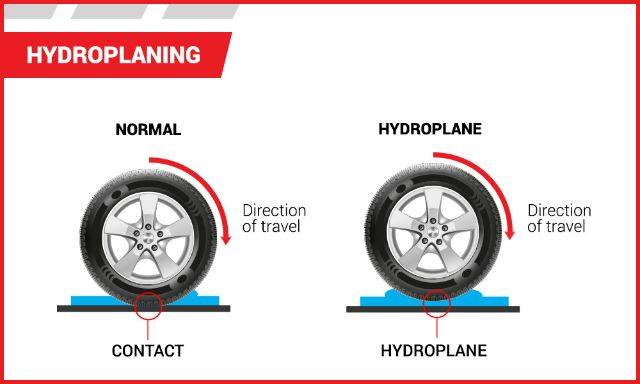Hydroplaning Explained: What Is It and How Can You Avoid It?

Now that the rainy season is in full swing, it’s time to practice better safety on the road, and one of the most hazardous issues you can encounter when the streets are wet is hydroplaning. What is it? How big of a problem does it pose? Understanding the problem and the circumstances that lead to it can go a long way toward avoiding the issues it presents.
 ©wikihow.com
©wikihow.comWhat is hydroplaning?
If you ever felt your vehicle skidding while driving on a wet road, even if you didn’t completely lose control of your car or even if it lasted for just a second, you most likely experienced hydroplaning. This condition, also known as aquaplaning, occurs when a tire can’t grip the road because of too much water. Water pressure combined with the rotation of the wheel pushes more water under the tire, which causes the tire to lose traction with the road. The result is the inability to steer or brake.
How does hydroplaning occur?
 ©tireamerica.com
©tireamerica.comLosing control over the vehicle can lead to feelings of helplessness. A terrifying experience, especially if the car is traveling at high speeds. That said, hydroplaning can still occur even if you’re traveling at speeds below 50 km/h, or even when a road is only slightly wet. In fact, hydroplaning is most dangerous during the first 10 minutes of light rain. Roads are often rich with oil residue, and when the oil mixes with rainwater, the chances of a hydroplaning accident increases.
Whether the roads are just a little damp from a recent shower or bombarded by torrential rain, hydroplaning is a very real and dangerous occurrence, and drivers should do everything in their power to prevent it.
How to avoid hydroplaning
Avoiding hydroplaning isn’t difficult if you know how it happens. Just keep a number of things in mind when you’re driving in the rain or on a wet road to lower the chances of your car sliding and losing control.
1. Drive at manageable speeds
Many road safety experts agree that speeds in excess of 50 km/h increases the chances of hydroplaning. As soon as you see raindrops on your windshield, lower your speed. Avoid overtaking other vehicles on the road, because such speed jumps put you at risk of hydroplaning. In fact, you should avoid sudden accelerations altogether.
2. Always check the condition of your tires
The more worn the tire, the bigger the chance of hydroplaning. Replace bald tires, as they can be detrimental on wet roadways. Have your tires rotated and balanced every time you get an oil change. Make sure they are properly inflated before you head out. There are tires designed to prevent hydroplaning, which can be particularly helpful during rainy seasons.
3. Turn off cruise control
If your vehicle has a cruise control function, never turn it on whenever there’s a downpour. If you begin hydroplaning with the function turned on, it will take longer for you to regain control of your vehicle.
4. Avoid puddles or standing water
If you can, steer clear of any parts of the road where you can obviously see that water has accumulated. All it takes is a small film of water for the car to begin hydroplaning.
5. Avoid hard braking
Don’t slam on the brakes when it’s raining. This is a surefire way to send your car into a skid, and you’ll likely lose control of your vehicle. Likewise, avoid sudden turns. If you need to brake, do so carefully.
What to do when you’re already hydroplaning
There are times when hydroplaning will still occur no matter how careful you are. If your vehicle starts skidding on a wet surface, there are steps you can take to regain control of your vehicle.
- Remove your foot from the accelerator. Again, applying brakes abruptly when you’re already sliding is a mistake. The best you can do is to step off the gas.
- Turn the steering wheel to the direction of the hydroplane. Have you watched the Cars animated movie? Do you remember the scene where the Doc was teaching Lightning McQueen to turn his front wheels opposite to the direction of the turn? Skidding is similar to drifting, and by turning your wheels to the direction of the hydroplane, you prevent losing further control of your car.
- Don’t panic. Wait for the tires to regain its grip on the road before doing anything else.
- After successfully recovering from a hydroplaning situation, you may need to park your car on a safe area for a few moments to allow your nerves to settle.
So there you have it, the hydroplaning basics that you need to know to keep safe on wet roads. Take care and be safe out there!
Featured Articles
- Latest
- Popular
Recommended Articles For You
Featured Cars
- Latest
- Upcoming
- Popular
Car Articles From Zigwheels
- News
- Article Feature
- Advisory Stories
- Road Test
